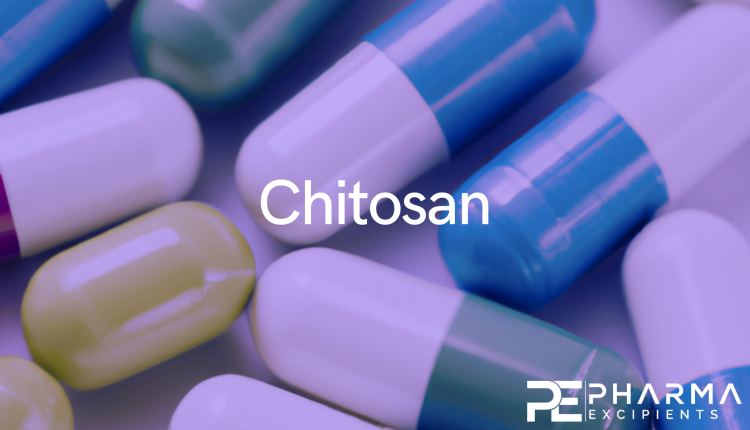Introduction to Chitosan as a pharmaceutical excipient
Chitosan as a pharmaceutical excipient
Chitosan is a biopolymer derived from chitin, a natural polymer found in the shells of crustaceans such as shrimp, crabs, and lobsters. It is a linear polysaccharide composed of randomly distributed β-(1→4)-linked D-glucosamine (deacetylated unit) and N-acetyl-D-glucosamine (acetylated unit). Chitosan has a range of applications due to its unique physical and chemical properties, including its ability to form films, gels, and beads, and its biocompatibility.
Chitin can also be extracted from insects or mushrooms. But these types of raw material are not used in pharmaceuticals sector yet, due to a lack of information (safety, impurities profile).
The properties of chitosans can be modified by varying the degree of deacetylation, molecular weight, and other factors during the production process. It is important to know / to specify parameter like degree of deacetylation, viscosity and/or molecular weight to achieve consistent properties as excipient.
Chitosan usage as excipient
As a pharmaceutical excipient, chitosans have been used as a binder, disintegrant, coating agent, and matrix material in various dosage forms, such as tablets, capsules, and films.
The USP-NF and EP monographs provide two different types of chitosans as a pharmaceutical excipient:
USP-NF: Chitosan
Chitosan is a white to off-white, odorless, tasteless powder or flake that is soluble in dilute acids and insoluble in water, alcohol, and most organic solvents. It is used as a tablet binder and disintegrant, and as a coating agent for tablets and capsules.
“Chitosan is obtained by partial deacetylation of chitin, which is extracted from the shells of edible shrimps and crabs suitable for human use. Its degree of deacetylation is NLT 70.0% and NMT 95.0%.” (USP text)
Synomyms: 2-Amino-2-deoxy-(1,4)-b-D-glucopyranan; deacetylated chitin; deacetylchitin; b-1,4-poly-D-glucosamine; poly-D-glucosamine; poly-(1,4-b-D-glucopyranosamine).
CAS Number: CAS 9012-76-4
EP: Chitosan Hydrochloride
Chitosan hydrochloride is the chloride salt of chitosan, normally leading to a deacetylation degree of 70.0% to 95.0%. It is a white or almost white fine powder, that is sparingly soluble water, practically insoluble in anhydrous ethanol.
Synomyms: chitosani hydrochloridum; , Chitosan HCl
CAS Number: CAS 70694 72 3
Video: Chitosan as a natural excipient
Uses and functions of chitosan in pharmaceutical formulations
- Tablet binder: Chitosan can be used as a binder to hold tablet ingredients together, improving tablet strength and reducing tablet friability.
- Disintegrant: Chitosan can also be used as a disintegrant to help tablets break down in the digestive tract and release their active ingredients more quickly.
- Coating agent: Chitosan has been used as a coating agent for tablets and capsules to improve their stability, prevent moisture uptake, and mask unpleasant tastes and odors.
- Matrix material: Chitosan can be used as a matrix material in transdermal patches to help control drug release rates and enhance skin permeation.
- Film-forming agent: Chitosan has also been used as a film-forming agent in oral films, which are thin, flexible films that dissolve quickly in the mouth for fast drug delivery.
- Microsphere and nanoparticle carrier: Chitosan can be used as a carrier material for microspheres and nanoparticles in drug delivery systems, helping to protect and release drugs at a controlled rate.
- Wound healing and tissue regeneration: Chitosan has shown promise in promoting wound healing and tissue regeneration, and has been used in various formulations such as dressings, gels, and films.
Overall, chitosan’s unique properties make it a versatile and attractive option for pharmaceutical formulation and drug delivery systems, with potential applications in a wide range of dosage forms.
Chitosan Production
The production of chitosan involves several steps, including the deacetylation of chitin, which is typically carried out using an alkaline solution such as sodium hydroxide. The resulting chitosan is then purified and dried to obtain a powder or flakes. See also the video for the different production steps.


